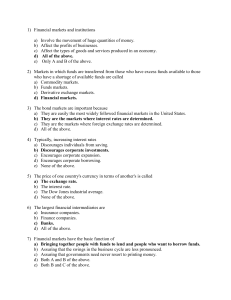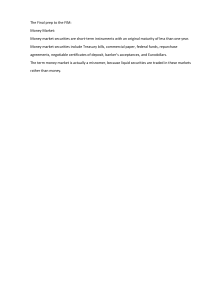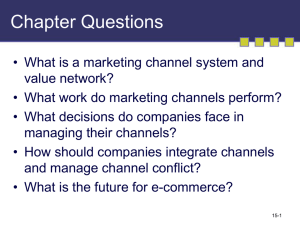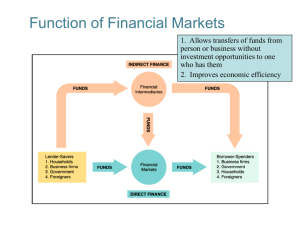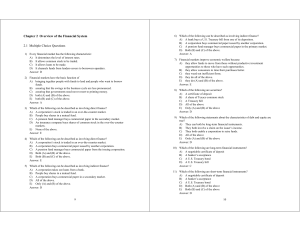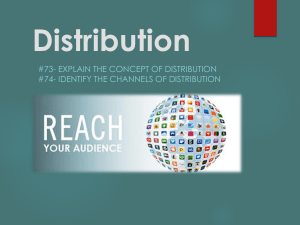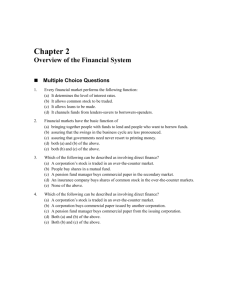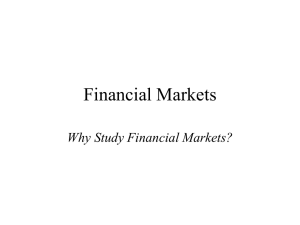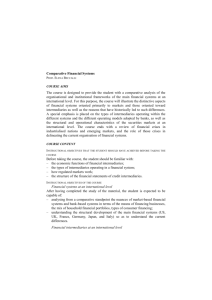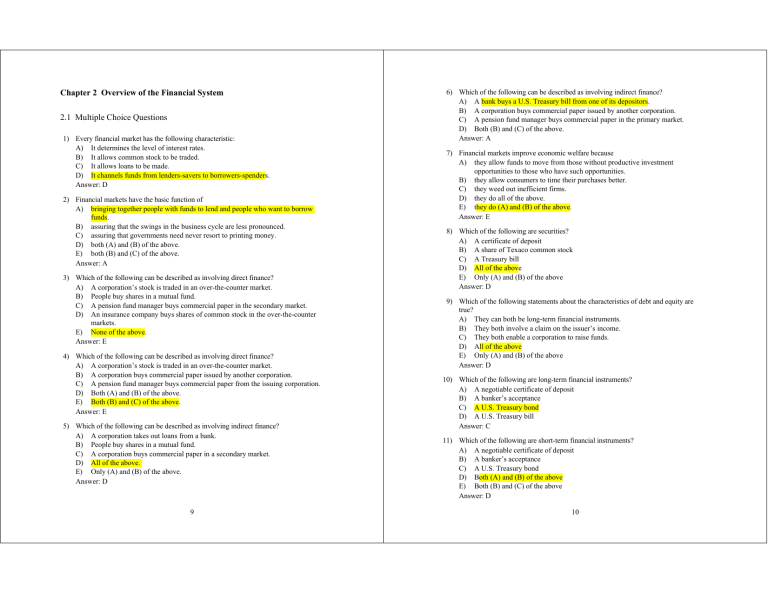
Chapter 2 Overview of the Financial System 2.1 Multiple Choice Questions 1) Every financial market has the following characteristic: A) It determines the level of interest rates. B) It allows common stock to be traded. C) It allows loans to be made. D) It channels funds from lenders-savers to borrowers-spenders. Answer: D 2) Financial markets have the basic function of A) bringing together people with funds to lend and people who want to borrow funds. B) assuring that the swings in the business cycle are less pronounced. C) assuring that governments need never resort to printing money. D) both (A) and (B) of the above. E) both (B) and (C) of the above. Answer: A 3) Which of the following can be described as involving direct finance? A) A corporation’s stock is traded in an over-the-counter market. B) People buy shares in a mutual fund. C) A pension fund manager buys commercial paper in the secondary market. D) An insurance company buys shares of common stock in the over-the-counter markets. E) None of the above. Answer: E 4) Which of the following can be described as involving direct finance? A) A corporation’s stock is traded in an over-the-counter market. B) A corporation buys commercial paper issued by another corporation. C) A pension fund manager buys commercial paper from the issuing corporation. D) Both (A) and (B) of the above. E) Both (B) and (C) of the above. Answer: E 5) Which of the following can be described as involving indirect finance? A) A corporation takes out loans from a bank. B) People buy shares in a mutual fund. C) A corporation buys commercial paper in a secondary market. D) All of the above. E) Only (A) and (B) of the above. Answer: D 9 6) Which of the following can be described as involving indirect finance? A) A bank buys a U.S. Treasury bill from one of its depositors. B) A corporation buys commercial paper issued by another corporation. C) A pension fund manager buys commercial paper in the primary market. D) Both (B) and (C) of the above. Answer: A 7) Financial markets improve economic welfare because A) they allow funds to move from those without productive investment opportunities to those who have such opportunities. B) they allow consumers to time their purchases better. C) they weed out inefficient firms. D) they do all of the above. E) they do (A) and (B) of the above. Answer: E 8) Which of the following are securities? A) A certificate of deposit B) A share of Texaco common stock C) A Treasury bill D) All of the above E) Only (A) and (B) of the above Answer: D 9) Which of the following statements about the characteristics of debt and equity are true? A) They can both be long-term financial instruments. B) They both involve a claim on the issuer’s income. C) They both enable a corporation to raise funds. D) All of the above E) Only (A) and (B) of the above Answer: D 10) Which of the following are long-term financial instruments? A) A negotiable certificate of deposit B) A banker’s acceptance C) A U.S. Treasury bond D) A U.S. Treasury bill Answer: C 11) Which of the following are short-term financial instruments? A) A negotiable certificate of deposit B) A banker’s acceptance C) A U.S. Treasury bond D) Both (A) and (B) of the above E) Both (B) and (C) of the above Answer: D 10 12) Which of the following are short-term financial instruments? A) A banker’s acceptance B) A share of Walt Disney Corporation stock C) A Treasury note with a maturity of 4 years D) All of the above Answer: A 13) Which of the following are primary markets? A) The New York Stock Exchange B) The U.S. government bond market C) The over-the-counter stock market D) The options markets E) None of the above Answer: E 14) Which of the following are secondary markets? A) The New York Stock Exchange B) The U.S. government bond market C) The over-the-counter stock market D) The options markets E) All of the above Answer: E 15) A corporation acquires new funds only when its securities are sold A) in the secondary market by an investment bank. B) in the primary market by an investment bank. C) in the secondary market by a stock exchange broker. D) in the secondary market by a commercial bank. Answer: B 16) Intermediaries who are agents of investors and match buyers with sellers of securities are called A) investment bankers. B) traders. C) brokers. D) dealers. E) none of the above. Answer: C 18) An important financial institution that assists in the initial sale of securities in the primary market is the A) investment bank. B) commercial bank. C) stock exchange. D) brokerage house. Answer: A 19) Which of the following statements about financial markets and securities are true? A) Most common stocks are traded over-the-counter, although the largest corporations have their shares traded at organized stock exchanges such as the New York Stock Exchange. B) A corporation acquires new funds only when its securities are sold in the primary market. C) Money market securities are usually more widely traded than longer-term securities and so tend to be more liquid. D) All of the above are true. E) Only (A) and (B) of the above are true. Answer: D 20) Which of the following statements about financial markets and securities are true? A) A bond is a long-term security that promises to make periodic payments called dividends to the firm’s residual claimants. B) A debt instrument is intermediate term if its maturity is less than one year. C) A debt instrument is long term if its maturity is ten years or longer. D) The maturity of a debt instrument is the time (term) to that instrument’s expiration date. Answer: C 21) Which of the following statements about financial markets and securities are true? A) Few common stocks are traded over-the-counter, although the over-the-counter markets have grown in recent years. B) A corporation acquires new funds only when its securities are sold in the primary market. C) Capital market securities are usually more widely traded than longer term securities and so tend to be more liquid. D) All of the above are true. E) Only (A) and (B) of the above are true. Answer: B 17) Intermediaries who link buyers and sellers by buying and selling securities at stated prices are called A) investment bankers. B) traders. C) brokers. D) dealers. E) none of the above. Answer: D 11 12 22) Which of the following markets is sometimes organized as an over-the-counter market? A) The stock market B) The bond market C) The foreign exchange market D) The federal funds market E) all of the above Answer: E 23) Which of the following instruments is not traded in a money market? A) Banker’s acceptances B) U.S. Treasury Bills C) Eurodollars D) Commercial paper E) None of the above Answer: E 24) Which of the following instruments is not traded in a money market? A) Banker’s acceptances B) U.S. Treasury Bills C) Eurodollars D) Commercial paper E) Residential mortgages Answer: E 25) Which of the following instruments are traded in a capital market? A) U.S. government agency securities B) Negotiable bank CDs C) Repurchase agreements D) Eurodollars E) None of the above Answer: A 26) Which of the following instruments are traded in a capital market? A) Corporate bonds B) U.S. Treasury bills C) Banker’s acceptances D) Repurchase agreements Answer: A 27) Bonds that are sold in a foreign country and are denominated in that country’s currency are known as A) foreign bonds. B) Eurobonds. C) Eurocurrencies. D) Eurodollars. Answer: A 13 28) Bonds that are sold in a foreign country and are denominated in a currency other than that of the country in which they are sold are known as A) foreign bonds. B) Eurobonds. C) Eurocurrencies. D) Eurodollars. Answer: B 29) Financial intermediaries A) exist because there are substantial information and transaction costs in the economy. B) improve the lot of the small saver. C) are involved in the process of indirect finance. D) do all of the above. E) do only (A) and (B) of the above. Answer: D 30) The main sources of financing for businesses, in order of importance, are A) financial intermediaries, issuing bonds, issuing stocks. B) issuing bonds, issuing stocks, financial intermediaries. C) issuing stocks, issuing bonds, financial intermediaries. D) issuing stocks, financial intermediaries, issuing bonds. Answer: A 31) The presence of transaction costs in financial markets explains, in part, why A) financial intermediaries and indirect finance play such an important role in financial markets. B) equity and bond financing play such an important role in financial markets. C) corporations get more funds through equity financing than they get from financial intermediaries. D) direct financing is more important than indirect financing as a source of funds. Answer: A 32) Financial intermediaries can substantially reduce transaction costs per dollar of transactions because their large size allows them to take advantage of A) poorly informed consumers. B) standardization. C) economies of scale. D) their market power. Answer: C 14 33) The presence of _____ in financial markets leads to adverse selection and moral hazard problems that interfere with the efficient functioning of financial markets. A) noncollateralized risk B) free-riding C) asymmetric information D) costly state verification Answer: C 34) When the lender and the borrower have different amounts of information regarding a transaction, ______________ is said to exist. A) asymmetric information B) adverse selection C) moral hazard D) fraud Answer: A 35) When the potential borrowers who are the most likely to default are the ones most actively seeking a loan, ______________ is said to exist. A) asymmetric information B) adverse selection C) moral hazard D) fraud Answer: B 36) When the borrower engages in activities that make it less likely that the loan will be repaid, _____________ is said to exist. A) asymmetric information B) adverse selection C) moral hazard D) fraud Answer: C 37) The concept of adverse selection helps to explain A) which firms are more likely to obtain funds from banks and other financial intermediaries, rather than from the securities markets. B) why indirect finance is more important than direct finance as a source of business finance. C) why direct finance is more important than indirect finance as a source of business finance. D) only (A) and (B) of the above. E) only (A) and (C) of the above. Answer: D 15 38) Adverse selection is a problem associated with equity and debt contracts arising from A) the lender’s relative lack of information about the borrower’s potential returns and risks of his investment activities. B) the lender’s inability to legally require sufficient collateral to cover a 100 percent loss if the borrower defaults. C) the borrower’s lack of incentive to seek a loan for highly risky investments. D) none of the above. Answer: A 39) When the least desirable credit risks are the ones most likely to seek loans, lenders are subject to the A) moral hazard problem. B) adverse selection problem. C) shirking problem. D) free-rider problem. E) principal-agent problem. Answer: B 40) Financial institutions expect that A) moral hazard will occur, as the least desirable credit risks will be the ones most likely to seek out loans. B) opportunistic behavior will occur, as the least desirable credit risks will be the ones most likely to seek out loans. C) borrowers will commit moral hazard by taking on too much risk, and this is what drives financial institutions to take steps to limit moral hazard. D) none of the above will occur. Answer: B 41) Successful financial intermediaries have higher earnings on their investments because they are better equipped than individuals to screen out good from bad risks, thereby reducing losses due to A) moral hazard. B) adverse selection. C) bad luck. D) financial panics. Answer: B 42) In financial markets, lenders typically have inferior information about potential returns and risks associated with any investment project. This difference in information is called A) comparative informational disadvantage. B) asymmetric information. C) variant information. D) caveat venditor. Answer: B 16 43) The largest depository institution at the end of 2001 was A) life insurance companies. B) pension funds. C) state retirement funds. D) none of the above. Answer: D 44) The value of assets held by commercial banks in 2001 was $6.7 trillion dollars, making commercial banks the A) second most important sector of financial intermediaries after mutual funds. B) second most important sector of financial intermediaries after life insurance companies. C) second most important sector of financial intermediaries after private pension funds. D) largest sector of financial intermediaries. Answer: D 45) Which of the following financial intermediaries are depository institutions? A) A savings and loan association B) A commercial bank C) A credit union D) All of the above E) Only (A) and (C) of the above Answer: D 46) Which of the following is a contractual savings institution? A) A life insurance company B) A credit union C) A savings and loan association D) A mutual fund Answer: A 47) Which of the following are not investment intermediaries? A) A life insurance company B) A pension fund C) A mutual fund D) Only (A) and (B) of the above Answer: D 48) Which of the following are investment intermediaries? A) Finance companies B) Mutual funds C) Pension funds D) All of the above E) Only (A) and (B) of the above Answer: E 17 49) The government regulates financial markets for three main reasons: A) to ensure soundness of the financial system, to improve control of monetary policy, and to increase the information available to investors. B) to improve control of monetary policy, to ensure that financial intermediaries earn a normal rate of return, and to increase the information available to investors. C) to ensure that financial intermediaries do not earn more than the normal rate of return, to ensure soundness of the financial system, and to improve control of monetary policy. D) to ensure soundness of financial intermediaries, to increase the information available to investors, and to prevent financial intermediaries from earning less than the normal rate of return. Answer: A 50) Asymmetric information can lead to widespread collapse of financial intermediaries, referred to as a A) bank holiday. B) financial panic. C) financial disintermediation. D) financial collapse. Answer: B 2.2 True/False 1) Every financial market allows loans to be made. Answer: FALSE 2) An example of direct financing is if you were to lend money to your neighbor. Answer: TRUE 3) The New York Stock Exchange is an example of a primary market. Answer: FALSE 4) Commercial paper is not traded in the capital market. Answer: TRUE 5) Eurodollars are traded in the money market. Answer: TRUE 6) The process of financial intermediation is also known as direct finance. Answer: FALSE 7) A mutual fund is not a depository institution. Answer: TRUE 8) A pension fund is not a contractual savings institution. Answer: FALSE 18 9) Equity represents an ownership interest in a firm and entitles the holder to the residual cash flows. Answer: TRUE 10) Adverse selection refers to those most at risk being most aggressive in their search for funds. Answer: FALSE 2.3 Essay 1) Distinguish between direct financing and indirect financing. 2) Distinguish between primary markets and secondary markets. 3) Why is it so important for an economy to have fully developed financial markets? 4) Why are financial intermediaries so important to an economy? 5) Describe how over-the-counter markets work. 6) What are adverse selection and moral hazard? 19 20
